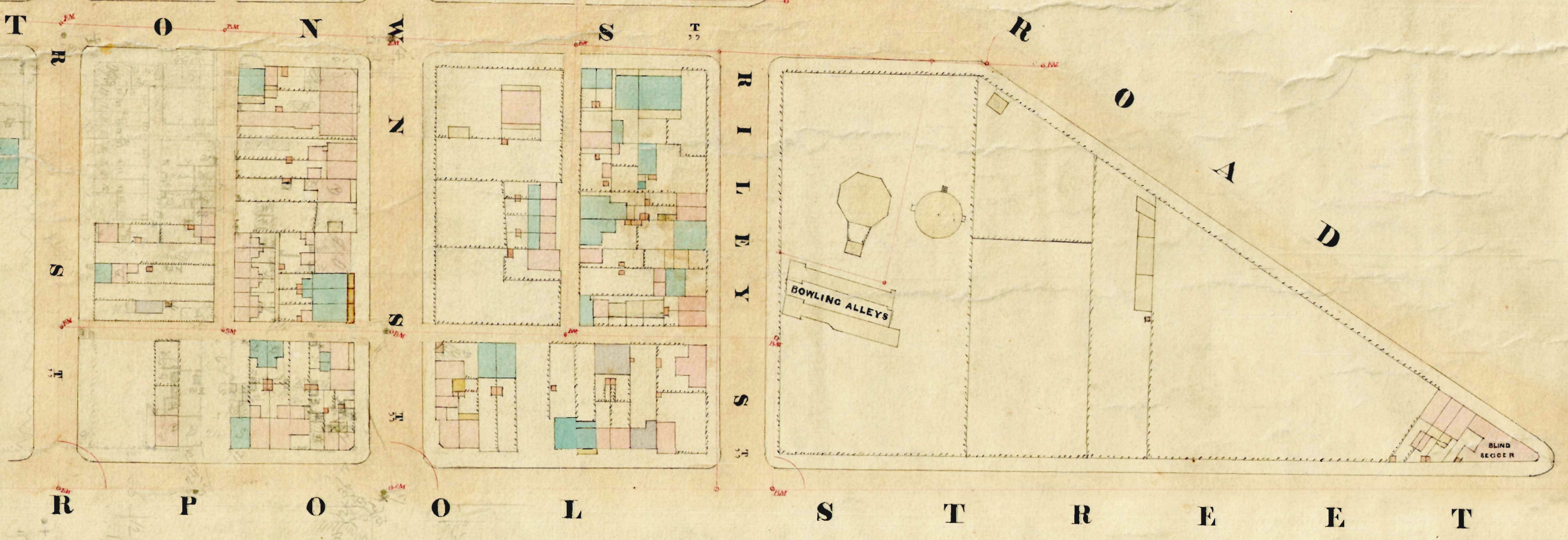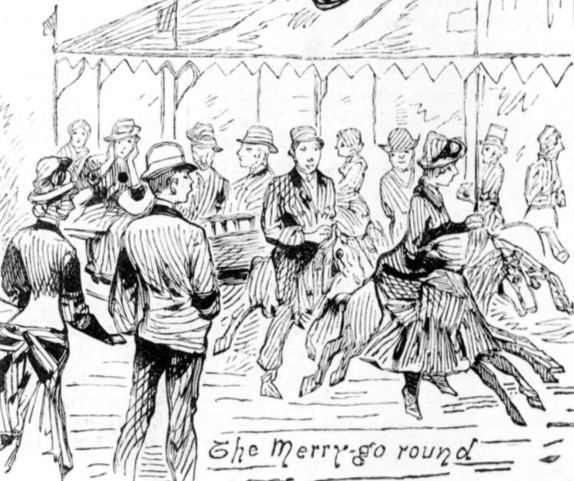In February 1855 a Mr Charles Smith announced he would be opening a new amusement precinct situated in a block bound by Liverpool, Riley and Oxford streets, Darlinghurst. According to one advertisement, Smith’s ‘magnificent Octagon Dancing Assembly Rooms’ were nearly completed and would be named the ‘Pavillion de Belle Vue’ because, as the name suggests, it had ‘one of the most beautiful views in Sydney’.

Detail from a survey plan of the south side of Liverpool Street, 11 February 1856
Showing the octagonal dance hall, merry-go-round and bowling alley facing Riley Street, surveyed by Edward Burrows, sheet 18, City of Sydney Archives, A-00880162
Initially open every evening, admission for men cost two shillings and sixpence, while women gained free entry. If patrons were to visit the new establishment, Smith had the following rules:
Gentlemen who introduce a lady in this establishment are to be responsible for such lady as top her respectability.
Ladies who wish to attend without a gentleman will please call for a ticket at Mr Smith’s residence, stating their name and residence.
Likewise, respectable parents, who wish their daughters to visit this highly respectable place of amusement, may procure tickets, gratis, in the day time.
Visitors must all be respectably dressed. Smoking is strictly prohibited in the ball room.1
By April, Smith and Company opened what they called a ‘Miniature Riding Establishment’, but was actually a merry-go-round. The company then leased part of the property to a Henry Miller to establish an ‘American Bowling Alley’, which opened on 2 August. Although by the end of the month, a Christopher Smith wrote requesting the City Commissioners force Miller to remove his bowling alley, claiming Miller had been ’telling falsehoods’ to customers and ‘drawing them all into his bowling alley’, leaving Smith and Co ‘without any earnings.’2
One resident, however, was less than impressed by Smith and Company’s ‘Places of Amusement’. On 19 May 1855 a ‘Mechanic’ wrote to Sydney’s Empire newspaper complaining of ‘houses of bad fame’. Concerned these ‘abominable receptacles of vice’ would cause an increase in the ‘moral depravity of society’, he drew attention to Smith’s establishment:
Now, sir, nearly under my own nose, at the junction of Riley-street with the South Head-road [Oxford Street], a party of foreigners have erected a Casino or dancing-house, close to which is a merry-go-round and a bowling alley (bowling alleys with 9 pins not being allowed by law within the city, but to evade the law this establishment has ten pins).
You have already pictured how homes through these places of resort have been " ploughed up," and how many an honest father and mother have cursed the hour when the law countenanced such hells upon earth as these Casinos….The merry-go-round may be considered an innocent and harmless recreation, but when placed alongside a dancing house it tends to mislead the unwary.
Around this bowling alley (mark of ten pins) are generally congregated from noon till or near midnight a congregation of the most unruly and unmannerly of both sexes, of various ages. lt is…away from all gas lamps, and as I fear from the vigilant eye of the police, that they give full scope to their immodest thoughts, and set the remonstrance of the respectable inhabitants of the neighbourhood at defiance, whilst others are amusing themselves all night long, the noise issuing from the place being like distant thunder, and may be distinctly heard at the lower South Head-road and on a great portion of…Hyde Park.3
By October 1858, the owner of the property was advertising the lease of the pavillion which included a well-stocked ‘kitchen garden, an extensive paddock, neatly laid-out flower garden’ which would be ‘suitable for a school or a private residence. Among the furniture and household items listed for sale was horsehair sofas and an American stove.
By the time the City surveyors produced plans of the area in 1855-65, all that remained of the structures was the dance hall, which eventually made way for housing.4

Detail of an illustration of a merry-go-round, 10 June 1885
‘Sketches at the Swiss Fair’, Melbourne, George Rossi Ashton, Wood engraving print, David Syme and Co, Accession No : IAN01/06/85/84
Explore the data behind these stories.
‘Advertising’, Sydney Morning Herald, 3 February 1855, 1, http://nla.gov.au/nla.news-article12965155. ↩︎
‘Advertising’, Sydney Morning Herald, 10 April 1855, 1, http://nla.gov.au/nla.news-article12967838, ‘Advertising’, Sydney Morning Herald, 2 August 1855, 1, http://nla.gov.au/nla.news-article12972383, ‘Advertising’, Sydney Morning Herald, 5 September 1855, 1, http://nla.gov.au/nla.news-article12978604. Letter: Christopher Smith. Requesting that the City Commissioners force Henry Miller to remove an (24/08/1855 - 31/08/1855), [A-00287261], City of Sydney Archives, https://archives.cityofsydney.nsw.gov.au/nodes/view/1093703. ↩︎
‘Night Amusements’, Empire, 30 May 1855, 5, http://nla.gov.au/nla.news-article60178001. ↩︎
‘Advertising’, Sydney Morning Herald, 4 October 1858, 7, http://nla.gov.au/nla.news-article13018830. ↩︎

